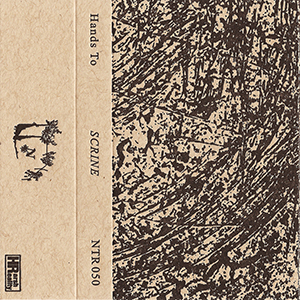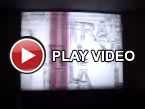Hands To, "Scrine"
 Scrine is one of the earlier works from Hands To, the name solo artist Jeph Jerman was working with at the time. With the project's first release just a year before in 1987, he was already a seasoned practitioner in the mid to late 1980s noise cassette scene. Even at this stage his work was highly conceptual, using his environment as a primary source for his compositions. Compared to his later works under his own name, however, there is a major emphasis on the sounds of urban and suburban environments, and a raw, rough edge that summarizes that era of noise perfectly.
Scrine is one of the earlier works from Hands To, the name solo artist Jeph Jerman was working with at the time. With the project's first release just a year before in 1987, he was already a seasoned practitioner in the mid to late 1980s noise cassette scene. Even at this stage his work was highly conceptual, using his environment as a primary source for his compositions. Compared to his later works under his own name, however, there is a major emphasis on the sounds of urban and suburban environments, and a raw, rough edge that summarizes that era of noise perfectly.
Much of the methodology Jerman has used in recent works under his own name was present back in the days of Scrine, but the location and source material is where differences are quite prevalent.For example, there are a number of examples of Jerman using found items from his home in Arizona, rocks and other naturally occurring items.When Scrine was recorded, however, it was done from an area he describes as "high crime" in Colorado Springs, and from within a nearby alley and actual junkyard, he captures the sound of urban decay.
Many of the techniques he uses are anything but obvious, but when referring to his liner notes, the "guerrilla recording" techniques he uses make sense and can largely be identified.For example, opening piece "Whag" is a mass of gusty whistles and squeaky, waxy scrapes of sound.There is a semblance of rhythm, an extremely loose one, throughout, which makes sense given that the piece is the result of him swinging a microphone around in the air like a lasso.Even with a lot of space in the mix, there is something disorienting throughout "Firad."Distant rumbling and passing fragments of children playing all fit together considering it is a multi-tracked series of neighborhood field recordings.
Jerman is working from a sparse set of sounds for "Thraal," with surges of static and loose cable noise peppering throughout the detuned sounding radio and broken equipment sounds, but he manages to do a lot with them.Considering the source was largely recordings of an old street sign that rattled about on windy days, that sonic pedigree can easily be heard.While his own memory is spotty about the recordings, I have to wonder that if it is the chaotic knocking and collapsing building vibes of "Plathers" that were constructed with him putting a tape deck into a clothes dryer or if that pops up somewhere else.
The pieces on the other half of the tape have a slightly different feel to them, although there is no indication that it was intended to be a distinct work.There is an odd, almost melodic element to "Sinc" that sounds like manipulated phone tones, which ends up creating the core that the clattering junk noise is constructed around.The last two pieces, "Mastic" and "Biasis 2" are works in which Jerman inadvertently lays the groundwork for what will later be known as harsh noise wall.The sustained grind of the former, complete with cut up moments and heavy stabs of noise is not that dissimilar to what Macronympha would heavily lean into a few years later.Lengthy closer "Biasis 2" has him staying rather static in his approach.A slow, magma like flow of heavy noise, shifting from higher registers to bassy ones does not relent until its closing moments.The dynamic may be a bit monochromatic, but the subtle changes that Jerman makes throughout have a lot of impact, and result is an excellent piece of early harsh noise.
Scrine definitely captures the feel of the mid/late 1980s experimental scene with its lo-fi, all analog recording sound, but the ingenuity from Jeph Jerman is quite clear.The unique manner in which he captured his source materials and the ambiguous way in which he blends them together would be characteristic of his work for the remainder of his career.However, I felt it especially strong in the context of this older, rawer style of noise, making Scrine an amazing archival release that deserves greater recognition three decades later.



